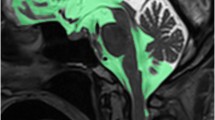Summary
Cardiac- and respiration-related movements of the cerebrospinal fluid (CSF) were investigated by MRI in 71 patients. In most patients with arteriosclerotic occlusive vascular disease CSF pulsations are normal. Decreased pulsatile flow is detectable in those with arteriovenous malformations, intracranial air and following lumbar puncture and withdrawal of CSF. Increased pulsatile flow in the cerebral aqueduct was found in 2 patients with large aneurysms, idiopathic communicating syringomyelia and in most cases of normal pressure hydrocephalus (NPH). CSF flow in the cervical spinal canal is, however, reduced or normal in NPH, indicating reduction of the unfolding ability of the surface of the brain and/or inhibition of rapid CSF movements in the subarachnoid space over its convexity.
Similar content being viewed by others
References
Kellie G (1824) An account of the appearance observed in the dissection of two of three individuals presumed to have perished in the storm of the 3rd, and whose bodies were discovered in the vicinity of Leigh on the morning of the 4th November 1821, with some reflections on the pathology of the brain. Trans Med Chir Soc (Edinb) 1: 84–169
Schroth G, Klose U (1992) Cerebrospinal fluid flow. I. Physiology of cardiac related CSF pulsations. Neuroradiology 35: 1–9
Schroth G, Klose U (1992) Cerebrospinal fluid flow. II. Physiology of respiration — related CSF pulsations. Neuroradiology 35: 10–15
Faiss J, Schroth G, Grodd W, König E, Will B, Thron A (1990) Central spinal cord lesions in stenosis of the cervical canal. Neuroradiology 53: 117–123
Gardner WJ, Abdullah AF, Cormack LJ (1957) The varying expressions of embryonal atresia of the fourth ventricle in adults. Arnold-Chiari malformation, Dandy-Walker syndrome, arachnoid cyst of the cerebellum and syringomyelia. J Neurosurg 14: 591–607
Gardner WJ (1965) Hydrodynamic mechanism of syringomyelia: its relationship to myelocele. J Neurol Neurosurg Psychiatry 28: 247–259
Schroth G, Palmbach M, Steinmetz H (1989) MRI of syringomyelia: comparison with clinical symptoms and pre-and postoperative results. In: Nadjmi M (ed) XVth Congress of the European Society of Neuroradiology 1988. Springer, Berlin Heidelberg New York, pp 187–190
Du Boulay GH, O'Connell J, Curie J, Bostick T, Verity P (1972) Further investigations on pulsatile movements in the cerebrospinal pathways. Acta Radiol 13:496–523
Hakim S, Adams RD (1965) The clinical problem of symptomatic hydrocephalus with normal cerebrospinal fluid pressure. Observations on cerebrospinal fluid hydrodynamics. N Neurol Sci 2:307–327
Adams RD, Fisher CM, Hakim S, Ojemann RG, Sweet WH (1965) Symptomatic occult hydrocephalus with “normal” cerebrospinal fluid pressure. A treatable syndrome. N Engl J Med 2: 307–327
Tator CH, Fleming JFR, Shepard RD, Turner VM (1968) A radioisotopic test for communicating hydrocephalus. J Neurosurg 28: 327–340
Kushner M, Younkin D, Weinberger J, Hurtig H, Goldberg H, Reivich M (1984) Cerebral hemodynamics in the diagnosis of normal pressure hydrocephalus. Neurology 34:96–99
Mathew NT, Meyer JS, Hartmann A, Ott EO (1975) Anormal cerebrospinal fluid blood flow dynamics. Implications in diagnosis, treatment, and prognosis in normal pressure hydrocephalus. Arch Neurol 32:657–664
Borgesen SE, Gjerris F (1987) Relationships between intracranial pressure, ventricular size, and resistance to CSF outflow. J Neurosurg 67:535–539
Vanneste J, Acker R von (1990) Normal pressure hydrocephalus: did publications alter management? J Neurol Neurosurg Psychiatry 53:564–568
Ball MJ, Dayan AD (1972) Pathogenesis of syringomyelia. Lancet II: 799–801
Du Boulay GH, Shah SH, Currie JC, Logue V (1974) The mechanism of hydromyelia in Chiari type 1 malformations. Br J Radiol 47: 579–587
Williams B (1971) Further thoughts on the valvular action of the Arnold-Chiari malformation. Dev Med Child Neurol 13 [Suppl 25]: 105–113
Author information
Authors and Affiliations
Rights and permissions
About this article
Cite this article
Schroth, G., Klose, U. Cerebrospinal fluid flow. Neuroradiology 35, 16–24 (1992). https://doi.org/10.1007/BF00588272
Received:
Issue Date:
DOI: https://doi.org/10.1007/BF00588272




